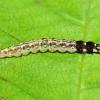35.027 Acompsia schmidtiellus (Heyden, 1848)
Acompsia cinerella <<Acompsia schmidtiellus>> Brachmia blandella
Status and Distribution
Very local, in southern England, south Wales and Norfolk with single, old records from Cornwall, Lincolnshire and Derbyshire.
National Status: Nationally Scarce B
Bradley & Fletcher no: 861

Photographer: © C M Manley
Location: Glamorgan
Provisional map
NBNSYS0100001410
Finding the Moth
Larva: in a folded or rolled leaf which can sometimes turn scarlet in colour.
Adult: can be disturbed and swept from amongst the foodplant and comes to light.
Similar Species
A large, broad-winged gelechiid with prominent palps which, due to its bright yellow-ochreous colouration, should not be confused with any other species.
May, June
July, August
Single brooded from late June to mid-August, rarely in mid-June and late August.
















